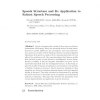Free Online Productivity Tools
i2Speak
i2Symbol
i2OCR
iTex2Img
iWeb2Print
iWeb2Shot
i2Type
iPdf2Split
iPdf2Merge
i2Bopomofo
i2Arabic
i2Style
i2Image
i2PDF
iLatex2Rtf
Sci2ools
80
Voted
NGC
2010
Springer
2010
Springer
Speech Structure and Its Application to Robust Speech Processing
Speech communication consists of three steps: production, transmission, and hearing. Every step inevitably involves acoustic distortions due to gender differences, age, microphone- and room-related factors, and so on. In spite of these variations, listeners can extract linguistic information from speech as easily as if the communications had not been affected by variations at all. One may hypothesize that listeners modify their internal acoustic models whenever extralinguistic factors change. Another possibility is that the linguistic information in speech can be represented separately from the extralinguistic factors. In this study, inspired by studies of humans and animals, a novel solution to the problem of intrinsic variations is proposed. Speech structures invariant to these variations are derived as transform-invariant features and their linguistic validity is discussed. Their high robustness is demonstrated by applying the speech structures to automatic speech recognition and ...
Related Content
| Added | 29 Jan 2011 |
| Updated | 29 Jan 2011 |
| Type | Journal |
| Year | 2010 |
| Where | NGC |
| Authors | Nobuaki Minematsu, Satoshi Asakawa, Masayuki Suzuki, Yu Qiao |
Comments (0)

